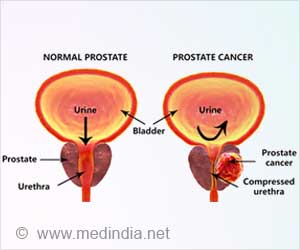- Angiotensin-converting enzyme inhibitors (ACEI) are a class of drugs used in the treatment of blood pressure. A similar class of drugs are the angiotensin receptor blockers (ARB), which can also lower blood pressure
- ACEIs and ARBs were compared to see which is linked to lung cancer. ACEIs were found to be strongly linked to the risk of developing lung cancer
- The association between ACEIs and lung cancer risk depends on the duration of use of ACEIs. The risk of lung cancer was evident after 5 years, peaking after more than 10 years
Read More..
What are Angiotensin Converting Enzyme Inhibitors (ACEI) and Angiotensin Receptor Blockers (ARB)?
- ACEI: These are drugs that prevent the angiotensin-converting enzyme (ACE) from catalyzing the reaction that converts the hormone angiotensin I to angiotensin II, which causes the blood vessels to narrow (vasoconstriction) causing the blood pressure to rise. Thus, ACEIs are used to treat hypertension by lowering the blood pressure.
- ARB: These are drugs that block angiotensin II from binding to its receptors on the blood vessel walls, thereby preventing vasoconstriction. Thus, ARBs relax the blood vessels, causing them to dilate (vasodilation), thereby reducing the blood pressure. Thus, like ACEIs, ARBs are also used to treat hypertension, but with a different mechanism of action.
Background of the Study
ACEIs and ARBs are not only used for the treatment of hypertension, but also other conditions, such as heart disease, renal insufficiency, and chronic kidney disease. ACEIs decrease the production of angiotensin II, whereas ARBs selectively blocks it from binding to the angiotensin receptors. These drugs target the renin-angiotensin aldosterone system (RAAS), which has been suspected to play a role in the development of cancer.Objective of the Study
The main objective of the study was to compare the use of ACEIs with ARBs to see which of these drugs cause an increased risk of lung cancer.Study Design
This was a population-based cohort study that utilized data from the UK Clinical Practice Research Datalink (CPRD). The patients were at least 18 years of age and had no history of cancer. The cohort consisted of 992,061 newly diagnosed high blood pressure patients who were prescribed antihypertensive drugs between January 1, 1995 and December 31, 2015. The main outcome that was measured was the incidence of lung cancer associated with the duration of use of ACEIs compared to ARBs.Study Findings
The study cohort was followed for a period of 6.4 years. During this period, a total of 7,952 cases of lung cancer were detected, with an incidence rate of 1.3 per 1000 person-years. Factors that could potentially influence the findings, such as age, sex, body mass index (BMI), smoking status, alcohol use (or abuse), and history of lung diseases were taken into consideration. After accounting for all these factors, it was found that the overall use of ACEIs were associated with an increased risk of lung cancer compared to ARBs, with an incidence rate of 1.6 vs 1.2 per 1000 person-years, respectively. The risk of lung cancer increased with longer duration of use of ACEIs, with an association becoming evident after 5 years of use and peaking after more than 10 years of use.Although the magnitude of the observed association was modest at the individual level, however, since ACEIs are one of the most widely prescribed classes of antihypertensive drugs, “so these small relative effects could translate into large absolute numbers of patients at risk,” the researchers pointed out. In this regard, Dr. Deirdre Cronin-Fenton, Associate Professor, Department of Clinical Epidemiology, Aarhus University, Aarhus, Denmark, in her editorial states: “Nonetheless, in an individual patient, concerns about the long-term risk of lung cancer should be balanced against gains in life expectancy associated with the use of ACEIs.”
Conclusion
This population-based cohort study revealed that ACEIs were associated with an increased risk of lung cancer. The association of ACEI use and lung cancer became particularly pronounced after 5 years of use of ACEIs. The researchers propose that the underlying mechanism for the association is due to the accumulation of bradykinin and substance P in the lungs, which have been implicated in lung cancer.Strengths of the Study
- With over 990,000 patients, this was the largest cohort ever used to establish the association between ACEI use and risk of lung cancer
- The use of prospectively registered, population-based CPRD data completely removed recall bias and minimized selection bias
- The cancer registration data from CPRD is highly reliable
- The CPRD allowed retrieval of data on several potential confounders, including smoking status
Limitations of the Study
- The study lacked information on confounders like socioeconomic status, diet, exposure to radon or asbestos and family history of lung cancer
- The CPRD prescriptions are by general practitioners, so there is a chance of misclassification of exposure if the patients did not adhere to the treatment regimen
- There is a possibility of misclassification of the outcome
- Since patients on ACEIs experience a persistent cough, chest x-rays for evaluation of the lung condition is very common, which increases the likelihood of detecting lung cancer, if present. This could lead to detection bias
Future Plans
The researchers indicate that the findings “should be replicated in other settings, particularly among patients exposed for longer durations.” So, they plan to carry out further studies with long-term follow-up to closely monitor the role of ACEIs on the incidence of lung cancer. This will help to enhance the scientific evidence on the long-term safety of these drugs.Funding Details
The study was funded by a Foundation Scheme grant from the Canadian Institutes of Health Research.Reference:
- Angiotensin converting enzyme inhibitors and risk of lung cancer: population based cohort study - (https://www.bmj.com/content/363/bmj.k4209)
Source-Medindia













